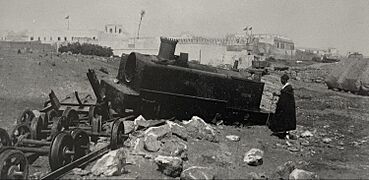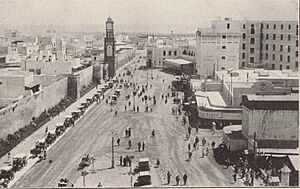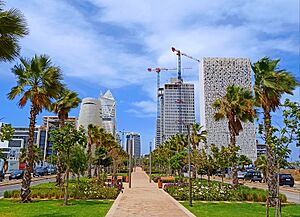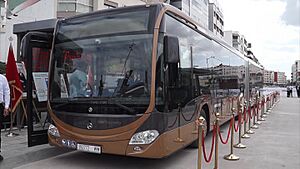Casablanca facts for kids
Quick facts for kids
Casablanca
|
|||
|---|---|---|---|
|
Twin Center
United Nations Square
Arab League Park
Royal Palace of Casablanca
Casablanca Cathedral
|
|||
|
|||
| Nickname(s):
Casa
|
|||
| Country | |||
| Region | Casablanca-Settat | ||
| First settled | 7th century BC | ||
| Reconstructed | 1756 | ||
| Founded by | Mohammed III | ||
| Elevation | 0 to 150 m (0 to 492 ft) | ||
| Population
(2014)
|
|||
| • City | 3,359,818 | ||
| • Rank | 1st in Morocco | ||
| • Metro | 4,270,750 | ||
| Demonym(s) | Kazāwi (كازاوي) Biḍāwi (بيضاوي) casablancais |
||
| Time zone | UTC+1 (CET) | ||
| Postal code |
20000-20200
|
||
Casablanca (which means "the White House" in Arabic) is the biggest city in Morocco. It is also the country's main place for business and money. The city is located on the Atlantic coast. About 3.7 million people live in the city area, and over 4.2 million live in the larger Casablanca region. This makes it the most populated city in the Maghreb region (Northwest Africa). It is also the eighth-largest city in the Arab world.
Casablanca has Morocco's most important port. The Port of Casablanca is one of the largest man-made ports in Africa. It is the third-largest port in North Africa. Casablanca is also home to the main naval base for the Royal Moroccan Navy.
The city is a major financial centre. In September 2023, it was ranked 54th globally for its financial importance. The Casablanca Stock Exchange is Africa's third-largest stock market. Many big Moroccan companies and large American and European companies have their main offices and factories here. Casablanca is known as the country's main industrial area.
Contents
- What's in a Name? The Story of Casablanca
- Casablanca's Past: A Journey Through Time
- Casablanca's Landscape and Weather
- Casablanca's Economy: A Hub of Activity
- How Casablanca is Organized
- People and Cultures of Casablanca
- Learning and Knowledge in Casablanca
- Places of Worship
- Sports in Casablanca
- Culture and Arts in Casablanca
- Getting Around Casablanca
- Exploring Casablanca: Top Tourist Spots
- Famous People from Casablanca
- City Connections: Twin Towns and Sister Cities
- See also
What's in a Name? The Story of Casablanca
The Old Name: Anfa
Before the 15th century, Casablanca was known as Anfa. This name was used on maps until around 1830. People had different ideas about where the name "Anfa" came from. Some thought it was from a tribe, others from a Hebrew word for a type of bird. But many believe it came from a local language called Tamazight. It might have meant "hill," "promontory on the sea," or "sandy beach."
How Casablanca Got Its Name
After a big earthquake in 1755, Sultan Mohammed ben Abdallah rebuilt the city. He renamed it "ad-Dār al-Bayḍāʾ" (الدار البيضاء), which means "The White House" in Arabic.
The name "Casablanca" has an interesting story. Some say it comes from a local legend about a holy man and his wife, Lalla al-Baiḍāʾ (meaning "White Lady"). Villagers would go to "Dar al-Baiḍāʾ" (House of the White) for supplies.
It seems there was a white building on a hill near the old ruins of Anfa. This building might have been a landmark for sailors. Portuguese sailors called the city "Casa Branca," meaning "White House" in Portuguese. Later, when the Spanish took over trade, they used "Casablanca," which is the Spanish version of "White House."
Even during the time when France controlled Morocco, the city kept the name Casablanca. Today, Moroccans still call it Casablanca, or just Casa for short.
Casablanca's Past: A Journey Through Time
Early Beginnings
The area where Casablanca stands today was first settled by Berbers around 700 BC. It was used as a port by the Phoenicians and later by the Romans. An ancient writer named Leo Africanus called it "Anfa," a great city founded in 744 AD. He said it was the most successful city on the Atlantic Coast because of its rich land.
Later, in the 14th century, Anfa became an important port under the Merinid rulers.
Portuguese and Spanish Influence
In the early 1400s, Anfa became an independent state again. It was a safe place for pirates. Because of this, the Portuguese attacked and destroyed the town in 1468. The new town that grew there was called Casa Branca by the Portuguese.
Between 1756 and 1790, Sultan Mohammed ben Abdallah rebuilt the city. He named it ad-Dār al-Bayḍāʼ, the Arabic translation of Casa Branca.
Growing into a Major Port
In the 1800s, Casablanca started to grow. It became a big supplier of wool to Britain. More ships came and went. By the 1860s, about 5,000 people lived there. This number grew to around 10,000 by the late 1880s. When French settlers arrived in 1906, the population was about 12,000. By 1921, it had jumped to 110,000.
The 1907 Bombardment
In 1906, an agreement gave France more power in Morocco. It allowed French officers to control the port of Casablanca and a French company to develop it. To build the port, a small railway was laid. It passed through a sacred graveyard. In June 1907, local tribesmen attacked the railway, killing nine workers.
In response, the French attacked the city in August 1907 with warships. They landed troops, causing a lot of damage. Many Moroccans were killed. This event opened the way for France to take more control of Morocco.
French Rule and City Planning
French control of Casablanca became official in March 1912. This was when the Treaty of Fez created the French Protectorate. Under French rule, Casablanca became a key port for sending goods out of Morocco.
The French decided to make Casablanca the economic capital of Morocco. A planner named Henri Prost designed a new European city outside the old city walls. He also designed a new area for Moroccans coming from other cities. Europeans made up almost half of Casablanca's population during this time.
World War II and the Anfa Conference
During World War II, American forces took control of Casablanca from French forces in November 1942.
The Anfa Conference
In January 1943, Casablanca hosted an important meeting called the Anfa Conference. British Prime Minister Winston Churchill and U.S. President Franklin D. Roosevelt met here to talk about the war. They decided that the Axis powers (Germany, Italy, Japan) would have to surrender completely.
President Roosevelt also met with Sultan Muhammad V. He told the Sultan that he supported Morocco becoming independent after the war. This meeting encouraged Moroccan people who wanted their country to be free.
Moving Towards Independence
In the 1940s and 1950s, Casablanca was a center for protests against French rule. Morocco gained independence from France in 1956.
Protests for Rights
In 1965, student protests started in Casablanca. They were asking for the right to higher education. These protests grew to include concerns from workers and others. In 1981, there were also protests in Casablanca because the prices of basic foods like butter and sugar went up a lot.
Women's Rights
In March 2000, many women's groups held demonstrations in Casablanca. They wanted to change laws to improve women's rights. They asked for an end to polygamy (a man having more than one wife) and for easier divorce laws. Although there was a large counter-demonstration, King Mohammed VI listened. In 2004, he introduced a new family law that met some of the women's demands.
In 2011, people in Casablanca also joined protests for political changes. In November 2023, Casablanca joined UNESCO's Creative Cities Network for its culture.
Casablanca's Landscape and Weather
Casablanca is on the Atlantic coast, in an area known for its fertile land. The only natural forest nearby is the Bouskoura forest. It was planted in the 20th century and has many eucalyptus, palm, and pine trees. It's located on the way to the city's international airport.
The city has a small seasonal stream called oued Bouskoura. Most of it is now covered due to city growth. The closest permanent river is Oum Rabia, about 70 kilometers to the south-east.
Climate of Casablanca
Casablanca has a hot-summer Mediterranean climate. This means it has warm, dry summers and mild, wet winters. The cool Canary Current from the Atlantic Ocean helps keep the temperatures from changing too much. The city gets about 412 millimeters of rain each year. The highest temperature ever recorded was 42.2°C, and the lowest was -1.5°C.
Casablanca's Economy: A Hub of Activity
The Casablanca region is like the engine of Morocco's economy. It has 32% of the country's factories and 56% of its industrial workers. The region uses 30% of Morocco's electricity. It also produces 44% of the country's industrial goods and 33% of its industrial exports. About 30% of Morocco's banks are in Casablanca.
One of Casablanca's most important exports is phosphate. Other industries include fishing, making canned fish, furniture, building materials, and textiles. They also produce electronics, leather goods, food, drinks, and cigarettes.
The ports of Casablanca and Mohammedia handle 50% of Morocco's international trade. Many new projects are happening along the Casablanca waterfront. These include big entertainment centers, shopping malls like Morocco Mall, and a renovated coastal walkway.
Casablanca is a major financial centre. The Casablanca Stock Exchange is Africa's third-largest. Many major companies have their main offices here. Royal Air Maroc, Morocco's national airline, has its main office near Mohammed V International Airport.
How Casablanca is Organized
Casablanca is a large city divided into eight main districts. These districts are then split into smaller areas called arrondissements. Each district has its own unique neighborhoods.
Some of the well-known neighborhoods include:
- Ain Diab
- Ain Sebaa
- Belvédère
- Bourgogne
- Californie
- Centre Ville
- Derb Sultan
- Habous
- Hay El Mohammadi
- Maârif
- Oasis
- Roches Noires
- Sidi Bernoussi
- Sidi Moumen
People and Cultures of Casablanca
In 2014, Casablanca had a population of over 3.3 million people. Almost all of them live in urban areas. About 25% of the population is under 15 years old. Casablanca is the largest urban area in the Maghreb region. Most of the people in Morocco are Arab and Berber Muslims.
During the time of French control, Europeans made up almost half of Casablanca's population. After Morocco became independent in 1956, the number of Europeans decreased. The city still has a small community of Moroccan Christians and foreign Christian residents.
Jewish Community in Casablanca
Jews have a long history in Casablanca. A Jewish community lived in Anfa before it was destroyed in 1468. The first Jewish synagogue in Casablanca was built around 1750.
In the mid-1800s, many Moroccan Jews moved from inland areas to coastal cities like Casablanca. They found new jobs in trade with Europeans. Casablanca's Jewish quarter was damaged during the 1907 bombardment.
Jewish people played a big role in building many of Casablanca's tallest buildings. Between 1948 and 1951, about 28,000 Moroccan Jews moved to Israel. Casablanca was a main departure point for this migration. Today, the Jewish community in Casablanca is smaller, with about 2,500 people in 2018.
The Jewish cemetery of Casablanca is still one of the city's major cemeteries. Many synagogues are still in use. The Moroccan Jewish Museum was opened in the city in 1997.
Learning and Knowledge in Casablanca
Colleges and Universities
Casablanca has several places for higher education:
- École Centrale Casablanca
- University of Hassan II Casablanca
- HEM Business School
- Université Mundiapolis
- Université Internationale de Casablanca
Schools for Kids
There are many international schools in Casablanca, offering different education systems:
- Belgian: École Belge de Casablanca
- French: Collège Anatole France, Lycée Lyautey, Groupe Scolaire Louis Massignon, Lycée La Résidence, Lycée Maïmonide, Lycée Léon l'Africain, École Normale Hébraïque, École Al Jabr
- Italian: Scuola "Enrico Mattei"
- Spanish: Instituto Español Juan Ramón Jiménez
- American: Casablanca American School, American Academy Casablanca, George Washington Academy
- Montessori: École Montessori Casablanca
Libraries to Explore
- Hassan II Mosque Foundation Multimedia Library
- King Abdul Aziz Foundation for Human Sciences and Islamic Studies
- Dar America
- Institut Français
- Instituto Cervantes
Places of Worship
Most of the places of worship in Casablanca are Muslim mosques. There are also some synagogues still in use. The city has Christian churches too. Some are still used by Christian communities, while others built during the colonial period have been changed for other purposes, like the Church of the Sacred Heart.
Sports in Casablanca
Football Fever
Casablanca is home to two very popular football clubs: Wydad Casablanca and Raja Casablanca. They are big rivals. Raja's symbol is an eagle, and Wydad's is a star and crescent. These clubs have helped develop some of Morocco's best players.
Both Raja CA (founded in 1949) and Wydad AC (founded in 1937) play in Morocco's top league, Botola. They play their home games at the Stade Mohammed V. Both teams have won the CAF Champions League three times.
Casablanca has hosted eight African Champions League finals at the Stade Mohammed V. This stadium also hosted the 2018 African Nations Championship Final. It might host matches for the 2030 FIFA World Cup.
Tennis Tournaments
Casablanca hosts the Grand Prix Hassan II, a professional men's tennis tournament. It started in 1986 and is played on clay courts. Famous winners include Thomas Muster and Stanislas Wawrinka.
Hosting Big Events
Casablanca has hosted several major sports events. These include the 1961 Pan Arab Games and the 1983 Mediterranean Games. Morocco will host the 2025 Africa Cup of Nations.
Sports Venues
- Stade Larbi Zaouli
- Stade Mohamed V
- Stade Sidi Bernoussi
- Complexe Al Amal de Casablanca
The Hassan II Stadium is a new football stadium planned for the city. It will be one of the largest stadiums in Africa, with a capacity of 93,000 people. It will be the home stadium for Raja Casablanca, Wydad Casablanca, and the Morocco national football team. It is expected to be finished by 2028 and will host matches for the 2030 FIFA World Cup.
Road Racing
The city also hosts the International Casablanca Marathon. This 26.2-mile race attracts runners from around the world.
Culture and Arts in Casablanca
Music Scene
Casablanca has a rich music history. Haja El Hamdaouia, a famous Aita music artist, was born here. The band Nass El Ghiwane came from Casablanca. Many popular Moroccan musicians, like Naima Samih and Abdelhadi Belkhayat, are from the city.
Casablanca also has a lively hip-hop scene with artists like El Grande Toto and Don Big. The city hosts music festivals such as Jazzablanca and L'Boulevard. There is also a museum dedicated to Andalusi music.
Literature and Books
The French writer Antoine de Saint-Exupéry is connected to Casablanca. Many novels and stories are set in the city, like Driss Chraïbi's The Simple Past. Casablanca hosts an International Book Fair every February.
Theater and Comedy
Tayeb Saddiki, known as the father of Moroccan theater, grew up and worked in Casablanca. Popular comedians like Hanane el-Fadili and Hassan El Fad are from here.
Visual Arts
The École des Beaux-Arts of Casablanca (School of Fine Arts) was founded in 1919. A group of artists called the Casablanca School developed a modern art movement from this school in the late 1960s.
L'Uzine is a community art and culture space in Casablanca. The city also has a street art festival called Sbagha Bagha, where artists create murals on buildings.
Photography and Film
Casablanca has been captured by many photographers. Marcelin Flandrin documented the early colonial period with his photos. Today, there's a lively street photography scene, with photographers like Yoriyas showing daily life in the city.
In the early 1900s, Casablanca had many movie theaters, some of the biggest in Africa. The famous 1942 American film Casablanca is set here, even though it was filmed in the U.S. Many Moroccan films, like Love in Casablanca and Casanegra, show life in the city.
Architecture and Design
Casablanca's buildings and city design are very important historically. The city has many different styles of buildings, including traditional Moroccan, colonial, Art Deco, and modern designs. During the French Protectorate, Casablanca was called a "laboratory of urbanism" because of its experimental city planning.
Organizations like Casamémoire work to protect and celebrate the city's unique buildings.
Getting Around Casablanca
Public Transport
The Casablanca Tramway is a modern tram system. As of 2019, it has two lines covering 47.5 kilometers with 71 stops. More lines are being built.
Casablanca is also planning a fast bus network called the Casablanca Busway. It will have two lines to help people travel around the city.
For many years, Casablanca planned to build a metro system to ease traffic. However, in 2014, the city decided it was too expensive and chose to expand the tram system instead.
Air Travel
Casablanca's main airport is Mohammed V International Airport. It is the busiest airport in Morocco. You can fly to many Moroccan cities from here, like Marrakech and Rabat.
It also has many international flights, especially to Europe, North America, the Middle East, and Africa. Important destinations include New York City, Paris, and London.
The older Casablanca-Anfa Airport was mostly closed in 2006 and later taken down. This area is now being used to build the "Casablanca Finance City".
Buses and Taxis
Private bus companies like CTM offer intercity buses to most Moroccan towns and some European cities. There are also local buses.
In Casablanca, you'll see two types of taxis. Petits taxis (small taxis) are red and work like regular cabs within the city. Grands taxis (big taxis) are white and are usually older Mercedes-Benz cars. They can be shared with other passengers on set routes or hired for private trips.
Train Travel
[[File:الطرامواي أمام محطة الدار البيضاء المسافري.jpeg|thumb|left|A tram on Casablanca's T1 line passes in front of Casa-Voyageurs railway station] Casablanca has three main train stations run by the national rail service, the ONCF.
- Casa-Voyageurs is the main station for long-distance trains. You can go south to Marrakech or north to Rabat and then to Tangier or Fes. It's also the southern end of the high-speed train line from Tangier. There's a special train service from this station to Mohammed V International Airport.
- Casa-Port mainly serves trains that travel shorter distances, like to Kenitra. It's close to the port and the city center. This station is being rebuilt to be more modern.
- Casa-Oasis was updated in the early 2000s. Now, all southern intercity trains stop here to help reduce crowding at Casa-Voyageurs.
Exploring Casablanca: Top Tourist Spots
Even though Mohammed V International Airport handles most international flights to Morocco, Casablanca is not as famous for tourism as cities like Fes or Marrakech.
The Hassan II Mosque is the city's main attraction. It is the second-largest mosque in Africa and the seventh-largest in the world. Many visitors also come to see the city's beautiful buildings and different architectural styles.
Popular places for Moroccan tourists include big shopping centers like Morocco Mall, Anfa Place, and the Marina Shopping Center. People also enjoy the Corniche and the beach at Ain Diab, as well as parks like the Arab League Park and the Sindibad theme park.
Famous People from Casablanca
[[File:Merieme Chadid.jpg|thumb|Merieme Chadid led an international scientific program to install a major astronomical observatory in Antarctica.]] Many talented people come from Casablanca, including:
- Lahcen Abrami – former Moroccan footballer
- Amal Ayouch – Moroccan actress
- Larbi Benbarek – Moroccan footballer
- Merieme Chadid – Moroccan astronomer
- Gad Elmaleh – famous comedian
- French Montana – Moroccan-American rapper
- Nawal El Moutawakel – Moroccan Olympic champion
- Noureddine Naybet – Moroccan footballer
- Jean Reno – Hollywood actor
- Frank Stephenson – award-winning car designer
- Tagne - rapper
City Connections: Twin Towns and Sister Cities
Casablanca is connected with many cities around the world. These connections help promote cultural exchange and friendship.
Casablanca is twinned with:
 Bordeaux, France
Bordeaux, France Busan, South Korea
Busan, South Korea Chicago, United States
Chicago, United States Dakar, Senegal
Dakar, Senegal Dubai, United Arab Emirates
Dubai, United Arab Emirates Jakarta, Indonesia
Jakarta, Indonesia Kuala Lumpur, Malaysia
Kuala Lumpur, Malaysia Muscat, Oman
Muscat, Oman Nouadhibou, Mauritania
Nouadhibou, Mauritania Shanghai, China
Shanghai, China
Casablanca also has cooperation agreements with:
 Abuja, Nigeria
Abuja, Nigeria Amman, Jordan
Amman, Jordan Amsterdam, Netherlands
Amsterdam, Netherlands Barcelona, Spain
Barcelona, Spain Buenos Aires, Argentina
Buenos Aires, Argentina Hebron, Palestine
Hebron, Palestine Istanbul, Turkey
Istanbul, Turkey Kajiado, Kenya
Kajiado, Kenya Koudougou, Burkina Faso
Koudougou, Burkina Faso Montreal, Canada
Montreal, Canada Moroni, Comoros
Moroni, Comoros Nouakchott, Mauritania
Nouakchott, Mauritania Paris, France
Paris, France Ramallah, Palestine
Ramallah, Palestine Rotterdam, Netherlands
Rotterdam, Netherlands Brussels, Belgium
Brussels, Belgium Madrid, Spain
Madrid, Spain London, United Kingdom
London, United Kingdom San Sebastián, Spain
San Sebastián, Spain Bucharest, Roumania
Bucharest, Roumania
See also
 In Spanish: Casablanca para niños
In Spanish: Casablanca para niños

































